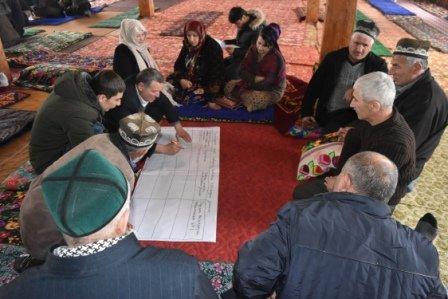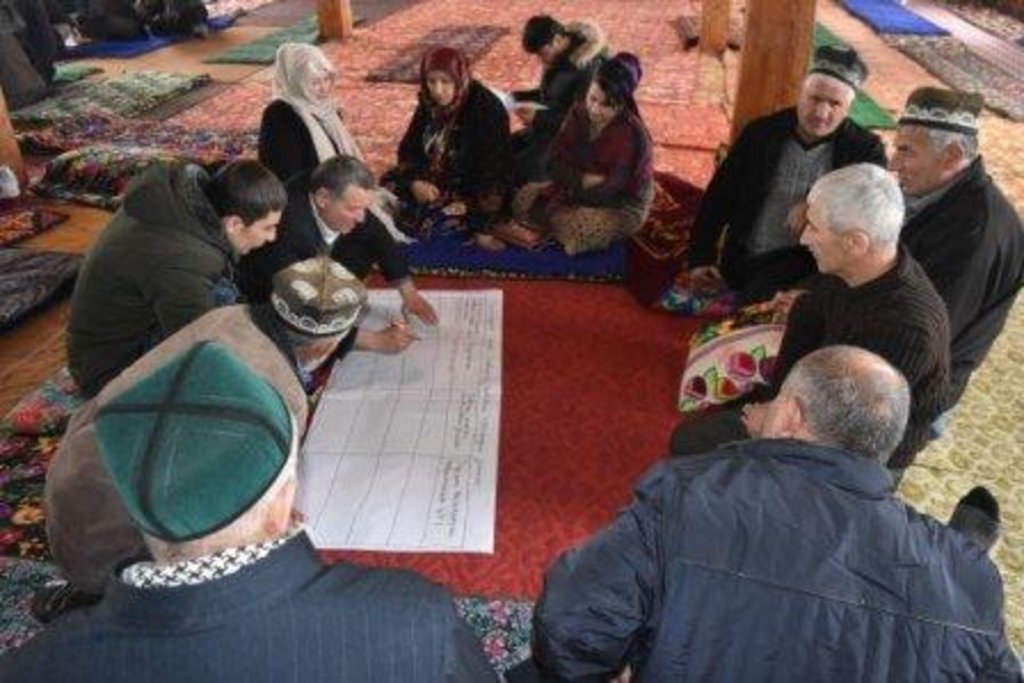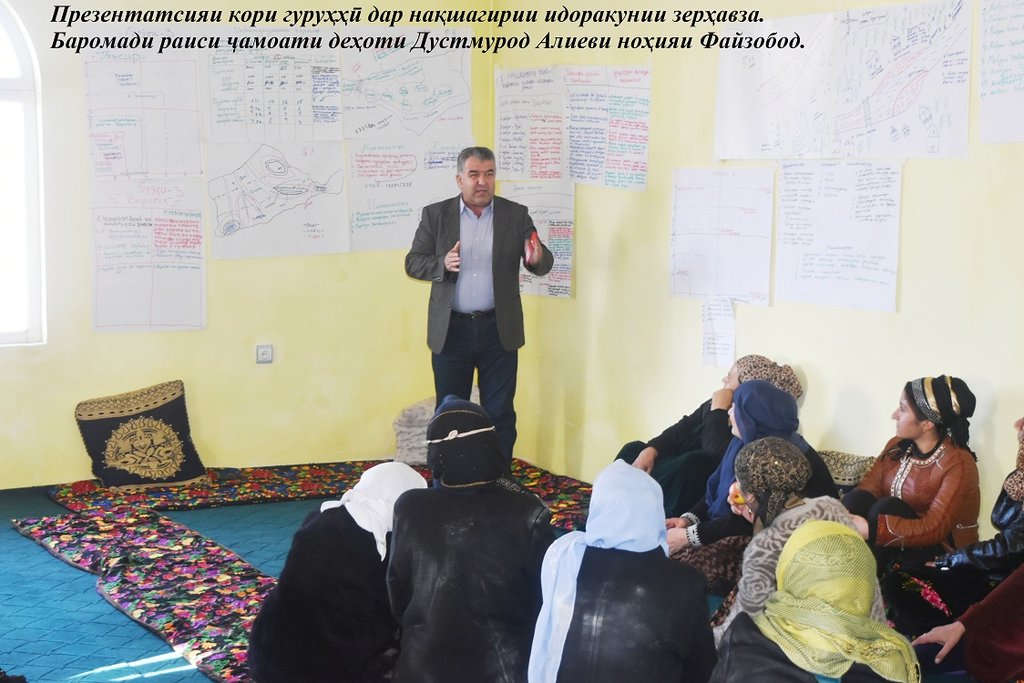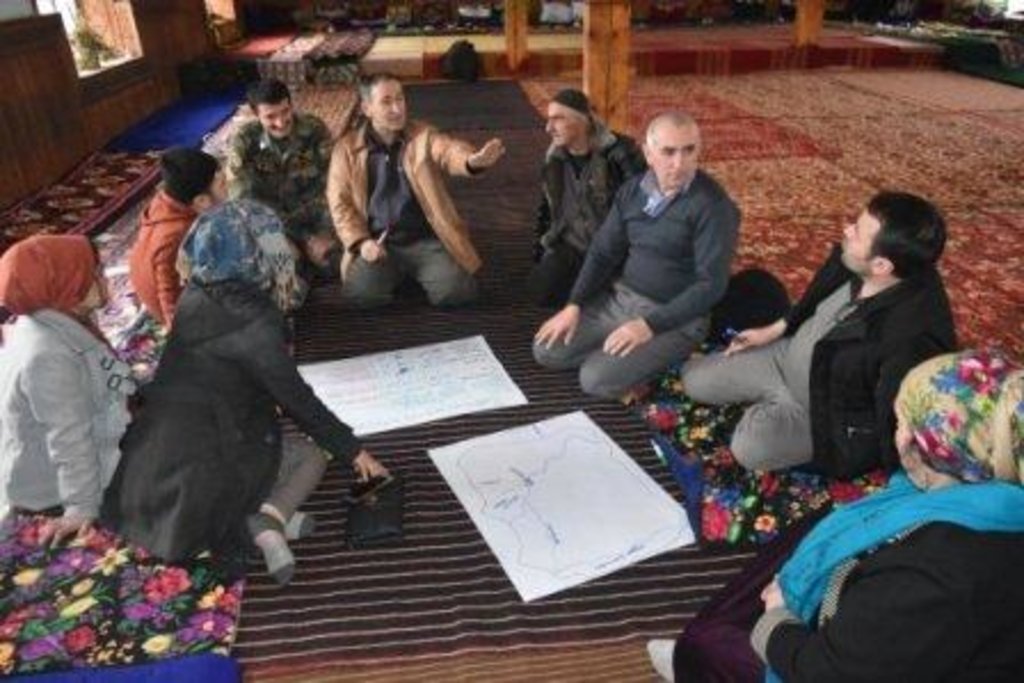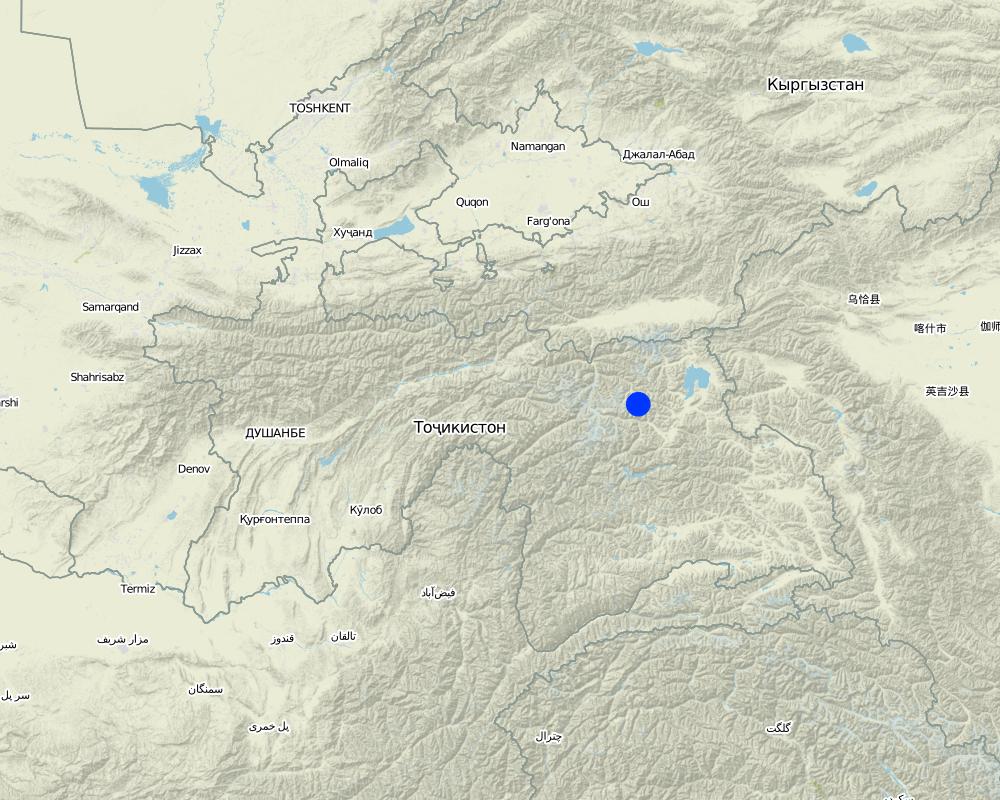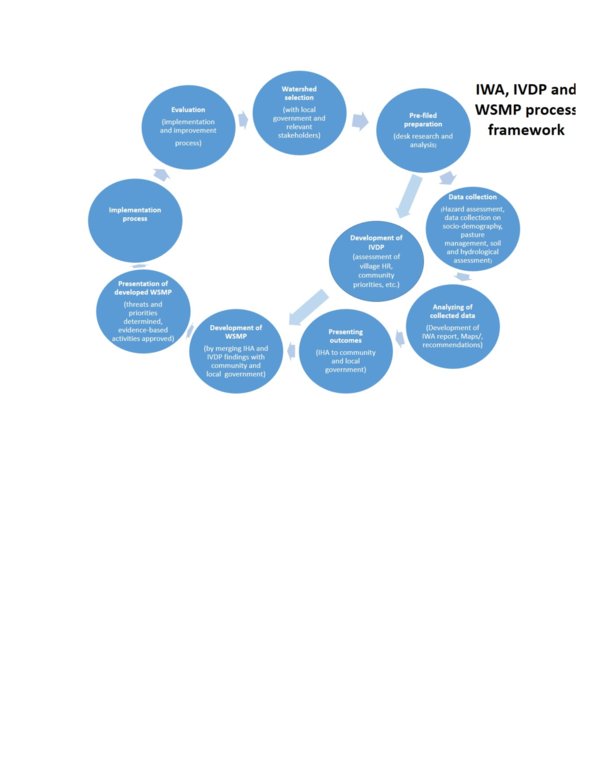Resilient Watershed Management Plan [ប្រទេសតាហ្ស៊ីគីស្ថាន]
- ការបង្កើត៖
- បច្ចុប្បន្នភាព
- អ្នកចងក្រង៖ Askarsho Zevarshoev
- អ្នកកែសម្រួល៖ –
- អ្នកត្រួតពិនិត្យ Farrukh Nazarmavloev
Идоракуни Хавза
approaches_3612 - ប្រទេសតាហ្ស៊ីគីស្ថាន
ពិនិត្យមើលគ្រប់ផ្នែក
ពង្រីកមើលទាំងអស់ បង្រួមទាំងអស់1. ព័ត៌មានទូទៅ
1.2 ព័ត៌មានលម្អិតពីបុគ្គលសំខាន់ៗ និងស្ថាប័នដែលចូលរួមក្នុងការវាយតម្លៃ និងចងក្រងឯកសារនៃវិធីសាស្ត្រផ្សព្វផ្សាយ
ឈ្មោះគម្រោងដែលបានចងក្រងឯកសារ/ វាយតម្លៃលើវិធីសាស្ត្រផ្សព្វផ្សាយ (បើទាក់ទង)
Integrated Health and Habitat Improvement in Rasht Valley, Tajikistanឈ្មោះអង្គភាពមួយ (ច្រើន) ដែលបានចងក្រងឯកសារ/ វាយតម្លៃលើវិធីសាស្ត្រផ្សព្វផ្សាយ (បើទាក់ទង)
Aga Khan Foundation (AKF) - ប្រទេសស្វ៊ីស1.3 លក្ខខណ្ឌទាក់ទងទៅនឹងការប្រើប្រាស់ទិន្នន័យដែលបានចងក្រងតាមរយៈវ៉ូខេត
តើពេលណាដែលទិន្នន័យបានចងក្រង (នៅទីវាល)?
21/02/2018
អ្នកចងក្រង និង(បុគ្គលសំខាន់ៗ)យល់ព្រមទទួលយកនូវលក្ខខណ្ឌនានាទាក់ទងទៅនឹងការប្រើប្រាស់ទិន្នន័យដែលបានចងក្រងតាមរយៈ វ៉ូខេត:
បាទ/ចា៎
1.4 ការយោងមួយ (ច្រើន) ទៅលើ (កម្រង) បញ្ជីសំណួរនៃបច្ចេកទេស SLM
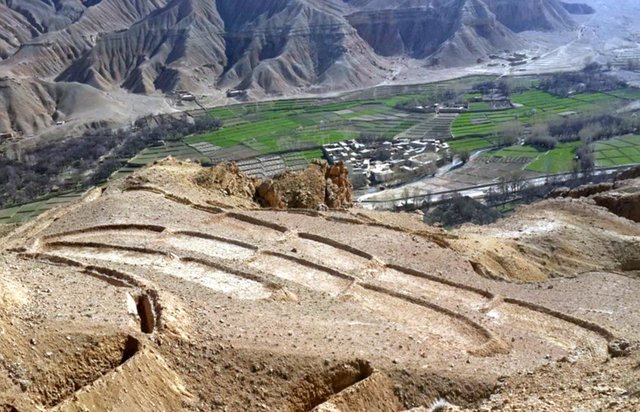
Terracing in Watershed [ប្រទេសអាហ្វហ្គានិស្ថាន]
Reshaping unproductive land into a series of levelled, gently-sloping platforms creates conditions suitable for cultivation and prevents accelerated erosion.
- អ្នកចងក្រង៖ Aqila Haidery
2. ការពណ៌នាអំពីវិធីសាស្ត្រផ្សព្វផ្សាយ SLM
2.1 ពណ៌នាសង្ខេបខ្លីពីវិធីសាស្ត្រផ្សព្វផ្សាយ
The participatory watershed management plan (WMP) is an interdisciplinary approach at community level to raise awareness on the watershed management concept and improve understanding of the watershed approach in planning and management of natural resource.
2.2 ពណ៌នាលម្អិតពិវិធីសាស្ត្រផ្សព្វផ្សាយ
ពណ៌នាលម្អិតពិវិធីសាស្ត្រផ្សព្វផ្សាយ:
In the participatory WMPs, the main emphasis is placed on identifying critical factors (or so called thresholds) in the sub-watershed and identifying management actions to reduce the potential of negative effects of these factors on the sub-watershed ecosystems and livelihoods. In the process of participatory WMP stakeholders will identify factors that people can control and factors they cannot control. The planning is different for factors that people can control (mitigation of risk factors), for instance sustainability measures of access to safe and clean drinking water, and factors they cannot control (adaptation to risk factors), for instance melting of glaciers and formation of risk-posing glacial lakes.
In WMPs stakeholders collaborate with the technical team to incorporate key findings of the Integrated Habitat Assessment (IHA). To enhance community ownership and participation in the implementation of local development plans, communities and local authorities will be fully involved in the identification, implementation, and handover of the planning process and intervention implementations.
Based on the action plan developed as a result of participatory WMPs, interventions will be implemented to regenerate, protect, or enhance land/resource conditions in the different parts of each sub-watershed in a holistic manner in line with the IWSM approach. Projects at the village level will be identified based on the village management plan and projects operating at the sub-watershed or multi-village level will be informed by WMPs. The resilient NRM activities will be designed to specifically contribute to the improved land use and stabilization of degraded areas in the sub-watershed. During design, protection and synergies will be considered with socio-economic development project.
The WMPs will be prepared for the purpose of enhancing communities’ sustainable development through building capacities and capabilities of local communities to manage and reduce risks from natural hazards, to improve natural resources management, land use planning and pasture management. To conduct the WMP process, a working group will be established at the sub-watershed level, which will include the head of the jamoat(s), representatives from relevant district government departments (Land Management, Geology, Agriculture, Environmental Protection), and representatives from local community based organizations.
The preparation process of the WMPs will be closely coordinated and consulted with the community based organizations as well as local governments with plans conducted at the sub-watershed level. It is tentatively planned that ownership of the plans will fall to either the jamoat government (if a sub-watershed covers only one jamoat) or the district government (in the case of sub-watersheds covering more than one jamoat). However, the ownership model and other aspects of WMP process is still not clear and should be piloted in a different scenario. The WMPs will enable the target sub-watersheds to make comprehensive planning and take into account socio-economic, disaster management, and natural resources management aspects.
As a result of this process, three WMPs were developed at three sub-watershed level in Rasht Valley of Kuksu, Surkhdara and Nushor sub-watersheds. As a result the watershed committee was supported with implementation of interventions, where immediate action was required to prevent further degradation. For example in the Nushori bolo sub-watershed in consultation with government and community mobilization it was agreed to ban grazing in the most degraded upper zone of the pasture, which had also a risk of landslide. In a short period after limiting grazing the pasture areas in the upper zone of watershed started to rehabilitate.
2.3 រូបភាពនៃវិធីសាស្ត្រផ្សព្វផ្សាយ
កំណត់សំគាល់ទូទៅរបស់រូបថត:
The head of the local government at the sub-district area which represents the selected watershed is presenting the agreed action plan to all stakeholders. The head of the local government is also a member of the working group on sub-watershed management together with the chairman and land use committee, environmental protection, forestry department.
2.5 ប្រទេស/តំបន់/ទីតាំងកន្លែង ដែលវិធីសាស្ត្រផ្សព្វផ្សាយត្រូវបានអនុវត្តន៍
ប្រទេស:
ប្រទេសតាហ្ស៊ីគីស្ថាន
តំបន់/រដ្ឋ/ខេត្ត:
Sub-ordinate regions
បញ្ជាក់បន្ថែមពីលក្ខណៈនៃទីតាំង:
Rasht Valley, Faizobod District
Map
×2.6 កាលបរិច្ឆេទនៃការចាប់ផ្តើម និងបញ្ចប់នៃវិធីសាស្រ្តផ្សព្វផ្សាយនេះ
ប្រសិនអត់ចាំឆ្នាំ សូមចង្អុលបង្ហាញកាលបរិច្ឆេទប្រហែលៗពេលដែលវិធីសាស្ត្រផ្សព្វផ្សាយត្រូវបានចាប់ផ្តើមប្រើ:
តិចជាង 10ឆ្នាំមុន (ថ្មី)
2.7 ប្រភេទនៃវិធីសាស្ត្រផ្សព្វផ្សាយ
- ផ្អែកលើគម្រោង/កម្មវិធី
2.8 គោលបំណង/ទិសដៅសំខាន់នៃវិធីសាស្ត្រផ្សព្វផ្សាយ
Improvement of natural resource management and prevention of natural hazards as a result of unsustainable use of natural resource.
2.9 លក្ខខណ្ឌអនុញ្ញាត ឬរារាំងការអនុវត្តន៍បច្ចេកទេសដែលស្ថិតនៅក្រោមវិធីសាស្រ្តផ្សព្វផ្សាយ
សង្គម/វប្បធម៌/ និងតម្លៃនៃសាសនា
- រារាំង
the sub-watershed covers several communities, where each community has its own management structure with social and cultural norms. sometimes the social and cultural norms in each communities do not agree with each other because of these different norms and interests.
ភាពអាចរកបាននៃធនធានហិរញ្ញវត្ថុ និងសេវាកម្ម
- អំណោយផល
the WMPs, which contains detail aspect of use on different land categories it attracts attention from different funders, including donors and government. in the framework of the project special fund was allocated fro implementation of the designed actions and interventions. This allowed land users and land specialist to implement several planned measures
បរិបទនៃស្ថាប័ន
- រារាំង
In the framework of this approach no legal institute exists to own the WMP
ការសហការ/ការសម្របសម្រួលតួអង្គពាក់ព័ន្ធ
- អំណោយផល
entails different categories of land use, which involves collaboration among different agencies and land users
ក្របខណ្ឌច្បាប់ (សិទ្ធិកាន់កាប់ដីធ្លី កម្មសិទ្ធីប្រើប្រាស់ដីនិងទឹក)
- រារាំង
there is not official institute, which is dedicated to watershed management. Therefore ownership of the plan is hindering further implementation after the project ends
អភិបាលកិច្ចដី (ការសម្រេចចិត្ត ការអនុវត្ត និងការរឹតបន្តឹង)
- អំណោយផល
The approach brings different local institutes, which are in charge of different natural resources together. This will enable an integrated approach to the natural resource management, as all of them are brought under one action plan.
ចំណេះដឹងស្តីពី SLM និងការទទួលបានការគាំទ្រផ្នែកបច្ចេកទេស
- អំណោយផល
The approach focuses on different SLM practices and sharing knowledge from different expertice
ទំហំការងារ ភាពអាចរកបាននៃកម្លាំងពលកម្ម
- រារាំង
High volume of migration of youth outside the area and high demand for labour force is hindering the process.
3. ការចូលរួម និងតួនាទីរបស់ភាគីពាក់ព័ន្ធ
3.1 អ្នកពាក់ព័ន្ធដែលបានចូលរួមក្នុងវិធីសាស្ត្រផ្សព្វផ្សាយ និងតួនាទីរបស់ពួកគេ
- អ្នកប្រើប្រាស់ដីក្នុងតំបន់/សហគមន៍
community members - farmers, livestock owners, forest owners
As first level of land users they are responsible for overall management of the natural resource and its conservation.
- អ្នកស្រាវជ្រាវ
researches - pasture specialist, geobotanics, soil specialist, hydrologist
are involved in technical assessment of the resources and support communities integration of findings into their plan
- គ្រូបង្រៀន/សិស្សក្មេងៗ/សិស្ស-និស្សិត
teachers on natural sciences and secondary school management
participate in the awareness raising session and support with knowledge sharing with schoolchildren, also use the new knowledge during classes.
- អង្គការក្រៅរដ្ឋាភិបាល
MSDSP Mountain Societies Development Support Programme
mobilization of stakeholders in development of their participatory plans
- រដ្ឋាភិបាលថ្នាក់មូលដ្ឋាន
all departments on natural resources management - land, forest, water, pasture
controlling, supervision and mainstreaming the new approach into their working plan
3.2 ការចូលរួមរបស់អ្នកប្រើប្រាស់ដីក្នុងតំបន់/ សហគមន៍ក្នុងតំបន់ក្នុងដំណាក់កាលផ្សេងគ្នានៃវិធីសាស្រ្តផ្សព្វផ្សាយ
| ការចូលរួមរបស់អ្នកប្រើប្រាស់ដីក្នុងតំបន់/សហគមន៍ក្នុងតំបន់ | សូមបញ្ជាក់នរណាត្រូវបានចូលរួម ព្រមទាំងពណ៌នាសកម្មភាពទាំងនោះ | |
|---|---|---|
| ការចាប់ផ្តើម/ការលើកទឹកចិត្ត | ការគាំទ្រពីខាងក្រៅ | supported by external consultants to provide feedback on the overall approach |
| ការរៀបចំផែនការ | អន្តរកម្ម | participatory approach is applied to develop the plan jointly with the land users |
| ការអនុវត្តន៍ | គំនិតផ្តួចផ្តើមដោយខ្ឡួនឯង | after the plan is developed and their awareness is raised they take initiative to implement the designed interventions. |
| ការត្រួតពិនិត្យ និងវាយតម្លៃ | អន្តរកម្ម | the project team jointly with the community members and working group established at the sub-watershed level conducted the monitoring. The working group, which consist of the project team and governmental officials have good knowledge on monitoring skills. |
3.3 គំនូសបំព្រួញ (ប្រសិនបើមាន)
ការពណ៌នា:
The watershed management circle including the whole circle of the planning process, starting from watershed selection up to evaluation.
អ្នកនិពន្ធ:
Zevarshoev Askarsho
3.4 ការសម្រេចចិត្តលើការជ្រើសរើសបច្ចេកទេស SLM
សូមបញ្ជាក់តើអ្នកណាជាអ្នកបានសម្រេចចិត្តក្នុងការជ្រើសរើសបច្ចេកទេសដើម្បីយកមកអនុវត្តន៍:
- គ្រប់ភាគីពាក់ព័ន្ធទាំងអស់ដែលជាផ្នែកនៃវិធីសាស្រ្តផ្សព្វផ្សាយដោយមានការចូលរួម
ចូរពន្យល់:
The plan is developed in a participatory way, so everybody is suggesting and participating in the decision making.
សូមបញ្ជាក់ តើការសម្រេចធ្វើឡើងដោយផ្អែកលើអ្វីជាមូលដ្ឋាន:
- វាយតម្លៃទៅលើចំណេះដឹងស្តីអំពី SLM ដែលបានចងក្រងជាឯកសារបានត្រឹមត្រូវ (ផ្អែកលើភស្តុតាងជាមូលដ្ឋានដើម្បីសម្រេចចិត្ត)
4. ជំនួយបច្ចេកទេស ការកសាងសមត្ថភាព និងការគ្រប់គ្រងចំណេះដឹង
4.1 ការកសាងសមត្ថភាព/ បណ្តុះបណ្តាល
តើវគ្គបណ្តុះបណ្តាលបានផ្តល់ឱ្យអ្នកប្រើប្រាស់ដី/អ្នកពាក់ព័ន្ធផ្សេងៗទៀតដែរឬទេ?
បាទ/ចា៎
សូមបញ្ជាក់តើអ្នកណាត្រូវបានបណ្តុះបណ្តាល:
- បុគ្គលិកចុះទីវាល/អ្នកផ្តល់ប្រឹក្សាយោបល់
ប្រសិនទាក់ទង សូមបញ្ជាក់ ភេទ អាយុ ស្ថានភាពគ្រួសារ ជនជាតិដើមភាគតិច។ល។:
women and man, 50-55, local people
ទម្រង់នៃការបណ្តុះបណ្តាល:
- វគ្គបណ្តុះបណ្តាល
ប្រធានបទបណ្តុះបណ្តាល:
Watershed Management
4.2 សេវាផ្តល់ប្រឹក្សាយោបល់
តើអ្នកប្រើប្រាស់ដីបានទទួលនូវសេវាផ្តល់ប្រឹក្សាដែរ ឬទេ?
ទេ
4.3 ការពង្រឹងសមត្ថភាពស្ថាប័ន (ការអភិរឌ្ឍន៍អង្គភាព)
តើស្ថាប័នទាំងអស់ត្រូវបានបង្កើតឡើង ឬពង្រឹងសមត្ថភាពតាមរយៈវិធីសាស្ត្រផ្សព្វផ្សាយដែរ ឬទេ?
- បាទ/ច៎ា តិចតួច
សូមបញ្ជាក់ថាតើស្ថាប័នត្រូវបានពង្រឹង ឬបង្កើតឡើងនៅត្រឹមកម្រិតណា(ច្រើន)?
- ថ្នាក់មូលដ្ឋាន
ចូពណ៌នាពីស្ថាប័ន តួនាទី និងទំនួលខុសត្រូវ សមាជិក ។ល។:
local level working group had been established to become owner of the watershed management plan. at the moment the working groups is unofficial and agreed to take of the plan implementation until the official structure is established
សូមបញ្ជាក់ប្រភេទនៃការគាំទ្រ:
- ការកសាងសមត្ថភាព/ បណ្តុះបណ្តាល
សូមផ្តល់ព័ត៌មានបន្ថែមទៀតឱ្យបានលម្អិត:
trainings for community on watershed management, pasture and land management was conducted
4.4 ការត្រួតពិនិត្យ និងវាយតម្លៃ
តើការត្រួតពិនិត្យ និងវាយតម្លៃគឺជាផ្នែកមួយនៃវិធីសាស្ត្រដែរឬទេ?
ទេ
4.5 ការស្រាវជ្រាវ
តើការស្រាវជ្រាវ គឺជាផ្នែកមួយនៃវិធីសាស្រ្តដែរឬទេ?
ទេ
5. ថវិកា និងសម្ភារៈឧបត្ថម្ភពីខាងក្រៅ
5.1 ថវិកាប្រចាំឆ្នាំសម្រាប់ផ្សព្វផ្សាយ SLM
ប្រសិនបើចំនួនពិតប្រាកដនៃថវិកាប្រចាំឆ្នាំមិនត្រូវបានដឹងច្បាស់ សូមប្រាប់ពីចន្លោះនៃថវិកានោះ:
- 10,000-100,000
មតិយោបល់ (ឧ. ប្រភពសំខាន់នៃមូលនិធិ/ម្ចាស់ជំនួយចំបង):
The implementation of the plan is depending on the size of the watershed and the condition to which extent it is degraded and requires rehabilitation measures.
5.2 ការគាំទ្រផ្នែកហិរញ្ញវត្ថុ / សម្ភារៈដែលបានផ្តល់ទៅឱ្យអ្នកប្រើប្រាស់ដី
តើអ្នកប្រើប្រាស់ដីបានទទួលការគាំទ្រផ្នែកហិរញ្ញវត្ថ/សម្ភារៈសម្រាប់ការអនុវត្តន៍បច្ចេកទេសដែរឬទេ:
ទេ
5.3 សូមបញ្ជាក់ពីធាតុចូលត្រូវបានផ្តល់បដិភាគ (រួមទាំងកម្លាំងពលកម្ម)
- គ្មាន
ប្រសិនបើកម្លាំងពលកម្មធ្វើដោយអ្នកប្រើប្រាស់ដី តើវាជាធាតុចូលដ៏សំខាន់មួយដែរ ឬទេ:
- ដោយស្ម័គ្រចិត្ត
5.4 ឥណទាន
តើឥណទានដែលបានផ្តល់នៅក្រោមវិធីសាស្ត្រផ្សព្វផ្សាយសម្រាប់សកម្មភាព SLM នេះយ៉ាងដូចម្តេច?
ទេ
5.5 ការលើកទឹកចិត្ត ឬវិធីសាស្ត្រដ៏ទៃទៀត
តើមានការលើកទឹកចិត្តផ្សេងទៀត ឬឧបករណ៍ប្រើប្រាស់ដើម្បីលើកកម្ពស់ការអនុវត្តន៍បច្ចេកទេស SLM?
បាទ/ចា៎
បើបាទ/ចា៎ សូមបញ្ជាក់:
Certain amount of funding was made available in the first phase to implement part of the action plan under the Watershed Management Plan
6. ការវិភាគរកផលប៉ះពាល់ និងសេចក្តីសន្និដ្ឋាន
6.1 ផលប៉ះពាល់នៃវិធីសាស្ត្រផ្សព្វផ្សាយ
តើវិធីសាស្ត្រផ្សព្វផ្សាយបានផ្តល់សិទ្ធិអំណាចដល់អ្នកប្រើប្រាស់ដី ធ្វើឱ្យប្រសើរឡើងនូវការចួលរួមអ្នកពាក់ព័ន្ធ?
- ទេ
- បាទ/ច៎ា បន្តិចបន្តួច
- បាទ/ច៎ា ជាមធ្យម
- បាទ/ច៎ា បានខ្លាំង
community members were fully involved in the planning process and participated in decision making with regards to interventions. in addition community members were selected to become member of working groups, which have the opportunity to participate in the overall management of the watershed
after development the plan community were supported with implementation of several intervention specific to each watershed to see the effects
តើវិធីសាស្ត្រផ្សព្វផ្សាយនេះធ្វើឱ្យចំណេះដឹងប្រសើឡើង និងសមត្ថភាពរបស់អ្នកប្រើប្រាស់ដីក្នុងការអនុវត្តន៏ SLM?
- ទេ
- បាទ/ច៎ា បន្តិចបន្តួច
- បាទ/ច៎ា ជាមធ្យម
- បាទ/ច៎ា បានខ្លាំង
the approach leads to the development of action plan with the expertise from SLM experts where different technologies are applied as a result of implementation of the actions related to watershed improvement
តើវីធីសាស្ត្រផ្សព្វផ្សាយនេះពង្រឹងចំណេះដឹង និងកសាងសមត្ថភាពរបស់អ្នកពាក់ព័ន្ធឬទេ?
- ទេ
- បាទ/ច៎ា បន្តិចបន្តួច
- បាទ/ច៎ា ជាមធ្យម
- បាទ/ច៎ា បានខ្លាំង
it involves also capacity building of the stakeholders and improves their awareness on the watershed management approach
តើវិធីសាស្ត្រផ្សព្វផ្សាយ បានធ្វើឱ្យប្រសើរឡើងសមភាពយេនឌ័រ និងផ្តល់សិទិ្ធអំណាចដល់ស្ត្រី និងក្មេងស្រី?
- ទេ
- បាទ/ច៎ា បន្តិចបន្តួច
- បាទ/ច៎ា ជាមធ្យម
- បាទ/ច៎ា បានខ្លាំង
It brings all stakeholders together to make decision with agreement with each other. women and girls also participated actively at the community planning process and were involved in the decision making
តើវិធីសាស្ត្រផ្សព្វផ្សាយបានលើកទឹកចិត្តដល់អ្នកប្រើប្រាស់ដីដែលជាយុវជន/ក្មេងជំនាន់ក្រោយឱ្យចូលរួមក្នុង SLM ?
- ទេ
- បាទ/ច៎ា បន្តិចបន្តួច
- បាទ/ច៎ា ជាមធ្យម
- បាទ/ច៎ា បានខ្លាំង
in the implementation process of intervention mainly were involved youth jointly with technical project team, NRM specialist and bio-soil engineering and had a chance to learn new technologies and skills
in the implementation process jointly with project experts, including NRM specialist and bio-soil engineer different SLM technologies were implemented at the sub-watershed level
តើវិធីសាស្ត្របានធ្វើឱ្យប្រសើរឡើងនូវការកសាងសមត្ថភាពរបស់អ្នកប្រើប្រាស់ដីដើម្បីបន្សុំាទៅនឹងការប្រែប្រួលអាកាសធាតុ/អាកាសធាតុក្តៅហែង និងកាត់បន្ថាយគ្រោះមហន្តរាយទាក់ទឹងនឹងអាកាសធាតុ?
- ទេ
- បាទ/ច៎ា បន្តិចបន្តួច
- បាទ/ច៎ា ជាមធ្យម
- បាទ/ច៎ា បានខ្លាំង
beside overgrazing, heavy precipitation in the last years have exacerbate the pasture degradation. through introducing new measures this contribute to minimize the effect of the heave precipitation, which is the cause of climate change.
តើវិធីសាស្ត្រផ្សព្វផ្សាយនេះនាំឱ្យមានការងារ ឱកាសរកប្រាក់ចំណូល?
- ទេ
- បាទ/ច៎ា បន្តិចបន្តួច
- បាទ/ច៎ា ជាមធ្យម
- បាទ/ច៎ា បានខ្លាំង
it only enable stakeholders and land users with improvement of land use and disaster protection
6.2 ការលើកទឹកចិត្តចម្បងៗរបស់អ្នកប្រើប្រាស់ដីសម្រាប់ការអនុវត្តបច្ចេកទេស SLM
- ការកាត់បន្ថយការធ្លាក់ចុះគុណភាពដី
In the long run the plan improves the land degradation by applying different methods and environmental protection measures.
- កាត់បន្ថយហានិភ័យនៃគ្រោះមហន្តរាយ
In most of the cases the forms of land use which lead to disasters were banned in order to rehabilitate the area. Different technologies were applied to reduce disaster risks.
- ច្បាប់ និងបទបញ្ជា (ផាកពិន័យ)/ការប្រតិបត្តិ
The approach focuses on improving the regulation on natural resource use in the watershed context as well as setting up common rules among different stakeholders to protect land.
6.3 សកម្មភាពផ្សព្វផ្សាយដែលប្រកបដោយចីរភាព
តើអ្នកប្រើប្រាស់ដីអាចធ្វើឱ្យមានចីរភាពនូវអ្វីដែលត្រូវបានអនុវត្តន៍តាមរយៈវិធីសាស្ត្រផ្សព្វផ្សាយដែរឬទេ(ដោយពុំមានការគាំទ្រពីអ្នកខាងក្រៅ)?
- មិនប្រាកដ
ប្រសិន ទេ ឬមិនប្រាកដសូមបញ្ជាក់ និងពន្យល់:
There is no legally registered entity who owns the plan as a result of the approach, otherwise the working group is consisting of governmental representatives and community members to manage the plan
6.4 ភាពខ្លាំង/ គុណសម្បត្តិនៃវិធីសាស្ត្រផ្សព្វផ្សាយ
| ភាពខ្លាំង/ គុណសម្បត្តិ/ ឱកាស ទស្សនៈរបស់អ្នកប្រើប្រាស់ដី |
|---|
| developed in participatory manner, involved in decision making |
| ភាពខ្លាំង/ គុណសម្បត្តិ/ ឱកាស ទស្សនៈរបស់បុគ្គលសំខាន់ៗ |
|---|
| represented by all parties involved in managing and using natural resource in the context of watershed |
| if legalized and owned by special entity can highly contribute to the improvement of natural resource conditions |
| could be replicated to other part/watershed as capacity on development of the approach is already built in the area |
6.5 ភាពខ្សោយ/ គុណវិបត្តិនៃវិធីសាស្ត្រ និងរកដំណោះស្រាយ
| ភាពខ្សោយ/ គុណវិបត្តិ/ ហានិភ័យក្នុងទស្សនៈរបស់បុគ្គលសំខាន់ៗ | តើបច្ចេកទេសទាំងនោះបានដោះស្រាយបញ្ហាដូចម្តេច? |
|---|---|
| absence of ownership interest over the plan developed as a result to the approach |
7. ឯកសារយោង និងវេបសាយ
7.1 វិធីសាស្ត្រ/ ប្រភពនៃព័ត៌មាន
- ការសម្ភាសន៍ជាមួយអ្នកប្រើប្រាស់ដី
13
- ការសម្ភាសន៍ជាមួយអ្នកជំនាញ/ ឯកទេស
4
- ការចងក្រងពីរបាកការណ៍ និងឯកសារផ្សេងៗទៀតដែលមាន
1
7.2 ឯកសារយោងដែលបានចេញផ្សាយ
ចំណងជើង អ្នកនិពន្ធ ឆ្នាំ ISBN:
Zevarshoev Askarsho
មានប្រភពមកពីណា? ថ្លៃដើមប៉ុន្មាន?
free, available upon request
7.3 ចូលទៅទាញយកឯកសារពាក់ព័ន្ធដែលមានលើបណ្តាញអ៊ិនធឺណែត
ចំណងជើង/ ពណ៌នា:
Zevarshoev Askarsho/Resilient Watershed Management Methodology
វេបសាយ:
available upon request
ការតភ្ជាប់ និងម៉ូឌុល
ពង្រីកមើលទាំងអស់ បង្រួមទាំងអស់ការតភ្ជាប់

Terracing in Watershed [ប្រទេសអាហ្វហ្គានិស្ថាន]
Reshaping unproductive land into a series of levelled, gently-sloping platforms creates conditions suitable for cultivation and prevents accelerated erosion.
- អ្នកចងក្រង៖ Aqila Haidery
ម៉ូឌុល
គ្មានម៉ូឌុល


